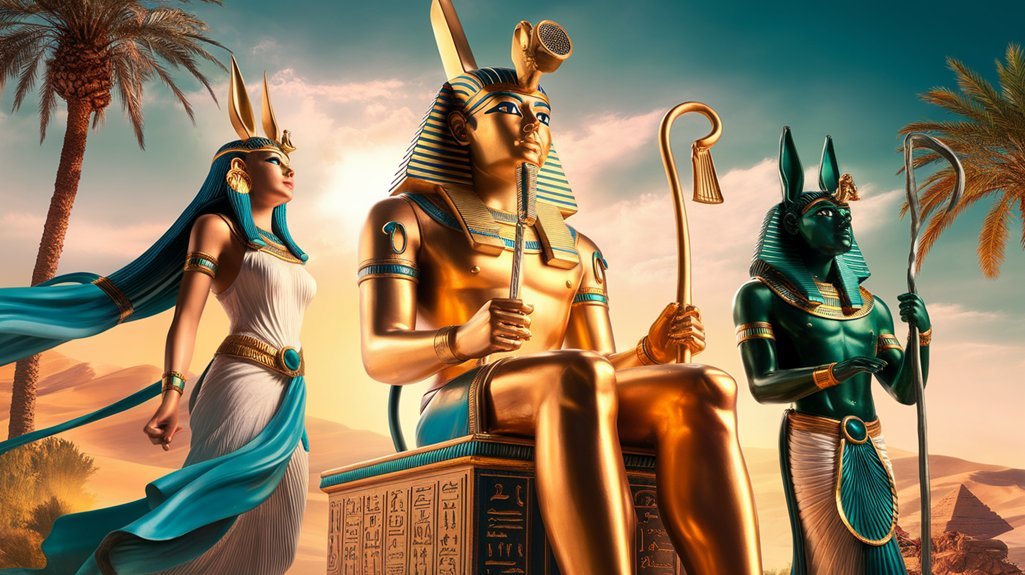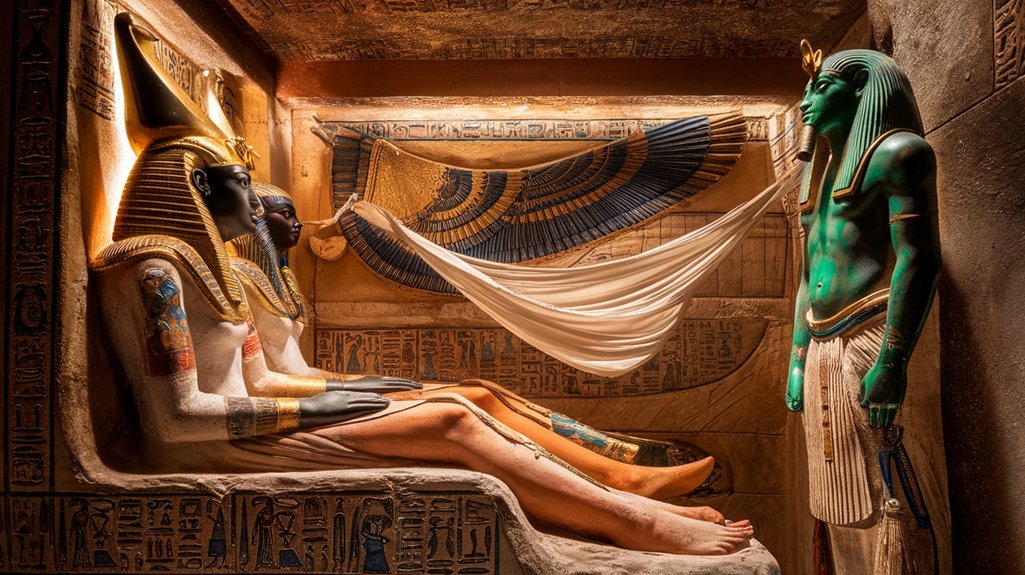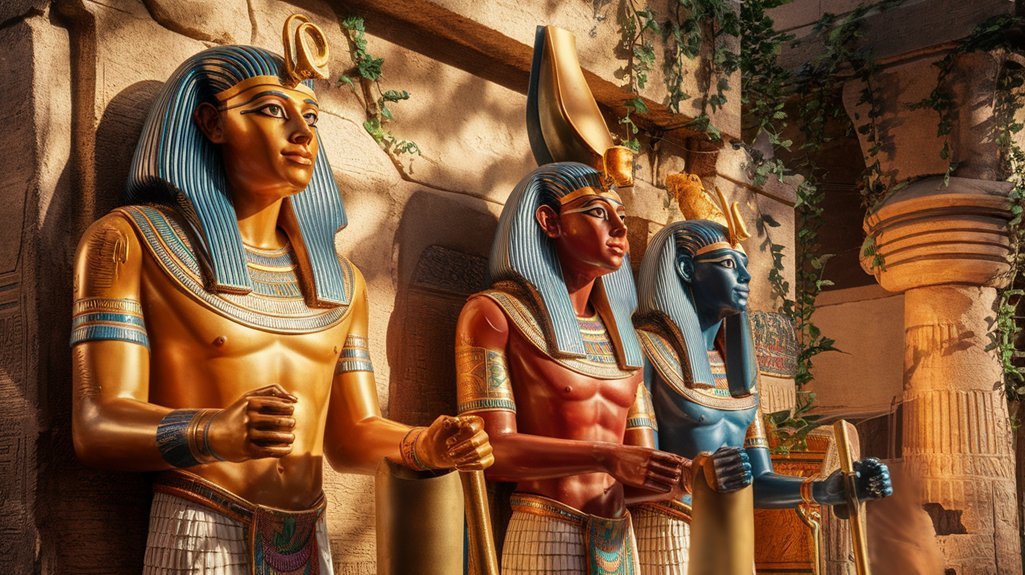As an Amazon Associate I earn from qualifying purchases.
↻
Last updated: December 6, 2025
You may recall the recent unveiling of the digitally reconstructed tomb of Osiris using augmented reality. This innovation illustrates how technology breathes new life into ancient Egyptian deities. As you explore Ra's cosmic journey, Isis's nurturing magic, and Osiris's role in the afterlife, consider the intricate methods behind these reconstructions. These efforts are rooted in archaeological discoveries and modern techniques, offering insights into ancient beliefs that still resonate today. What more lies beneath these sands?
Key Takeaways
- Archaeological discoveries and artifacts offer tangible links to ancient Egyptian mythology and gods like Ra, Isis, and Osiris.
- Technological innovations such as 3D modeling and augmented reality enhance interactive experiences of ancient deities.
- Modern cultural and artistic expressions integrate symbolism of Ra, Isis, and Osiris into contemporary festivals and spiritual practices.
- Community efforts focus on authentic recreations of ancient rituals and educational programs to preserve cultural heritage.
- Immersive museum exhibits provide engaging, firsthand experiences of Egyptian mythology, enhancing public understanding and appreciation.
The Resurgence of Egyptian Mythology in Modern Times

In recent years, the fascination with Egyptian mythology has undergone a significant revival, driven by both academic interest and popular culture. You're witnessing a mythological resurgence that highlights the cultural significance of ancient Egypt's pantheon in today's world. This renewed interest emerges not only in scholarly circles, where researchers meticulously explore ancient texts and artifacts, but also in media and entertainment, where these mythologies are reimagined and brought to life.
As you delve deeper, you'll find that Egyptian mythology offers rich narratives that resonate with contemporary themes, including power, morality, and cosmic balance. This cultural significance is reflected in the way modern adaptations capture the imagination, allowing ancient deities to emerge as symbols of timeless human experiences. By engaging with these stories, you gain insights into how ancient Egyptians understood their world, offering a profound connection between the past and present that continues to captivate and educate.
Unveiling the Mysteries of Ra, the Sun God
To truly understand Ra's significance, you must examine the intricate symbolism and iconography that depict him as the embodiment of the sun. Ra's daily journey across the sky, from dawn to dusk, represents not only the passage of time but also the cyclical nature of life and renewal. By analyzing these elements, you can gain insights into how ancient Egyptians perceived the cosmos and their place within it.
Symbolism and Iconography
Amidst the vast pantheon of ancient Egyptian deities, Ra stands out as a paramount figure whose symbolism and iconography offer profound insights into the civilization's cosmology. As the embodiment of the sun, Ra's mythological symbolism is multifaceted, reflecting both creation and destruction. You'll find him depicted with a falcon head crowned by a sun disk, signifying his dominion over light and life. His ancient iconography further includes:
- The Aten: a sun disk encircled with rays ending in hands, illustrating divine benevolence.
- The scarab beetle: representing transformation and rebirth, tied to Ra's daily renewal.
- The solar barque: symbolizing his journey across the sky, emphasizing cyclical time.
These elements underscore Ra's integral role in the Egyptian worldview, intertwining the divine with the terrestrial.
Ra's Daily Journey
Few myths captivate quite like the ancient Egyptians' tale of Ra's daily journey across the sky. As the sun god, Ra's symbolism embodies the cycle of life and renewal. Each dawn, he sails his solar barque, illuminating the world and asserting Ra's influence in the cosmos. Ra's mythology describes his voyage as a battle against chaos, reinforcing Ra's attributes as a protector. Through rituals and festivals, Ra's worshipers celebrated his triumph, reflecting on Ra's connections with life's continuity. Ra's representation as a falcon-headed deity highlights his divine oversight. This journey not only underscores Ra's legacy but also integrates deeply with Egyptian culture. Understanding Ra's daily passage reveals insights into ancient beliefs that shaped civilization's spiritual and temporal realms.
Reimagining Isis: The Goddess of Magic and Motherhood

As you explore the reimagining of Isis, consider her dual symbolism as both a powerful sorceress and a nurturing mother, integral to Egyptian mythology and cultural identity. Analyzing modern interpretations, you'll find that her influence extends beyond ancient texts, where practitioners today adapt her attributes to contemporary spiritual practices, highlighting her enduring relevance. By examining these cultural impacts, you can better understand how Isis's archetype continues to shape and inspire concepts of magic and motherhood in modern society.
Symbolism and Cultural Impact
The transformation of Isis from an ancient deity to a symbol of contemporary cultural relevance exemplifies the enduring power of myth and symbolism. Through cultural fusion and mythological storytelling, Isis transcends time, becoming a powerful emblem of magic and motherhood. Her influence extends beyond Egyptian borders, resonating with diverse cultures and beliefs. You'll find her:
- Embodied in modern feminist movements, representing strength and nurturing.
- Serving as a bridge between ancient history and present-day spiritual practices.
- Inspiring artistic expressions, from literature to visual arts.
Modern Interpretations and Practices
In contemporary society, the reimagining of Isis unfolds as a fascinating interplay between ancient mythology and modern cultural dynamics. You see Isis as more than a deity; she embodies mythical symbolism that resonates with today's values. Her attributes as the goddess of magic and motherhood are reinterpreted, aligning with contemporary practices emphasizing empowerment and nurturing. This reinterpretation allows you to connect with her through rituals, art, and literature, reinforcing her relevance. By embracing Isis's symbolism, you engage with themes of transformation and protection. Modern followers incorporate her imagery into rituals that honor her legacy while adapting to current contexts. Thus, Isis's enduring presence illustrates how ancient deities can inspire and evolve within modern spiritual landscapes, bridging past and present.
Osiris: The Keeper of the Afterlife
Osiris, a pivotal figure in Egyptian mythology, embodies the essence of life, death, and rebirth, serving as the keeper of the afterlife. His role is crucial in understanding ancient Egyptian afterlife beliefs, where he symbolizes hope for eternal existence. Osiris' significance is profound, as he's seen as a model for resurrection and moral order. His myth illustrates how the cycle of life is intertwined with death, offering insights into the Egyptians' view of mortality.
To grasp Osiris' impact:
- Osiris' Significance: He represents justice and the triumph over chaos.
- Afterlife Beliefs: Egyptians viewed him as the judge of the dead, guiding souls to the afterlife.
- Symbolism: His green skin signifies rebirth, and the crook and flail he holds depict kingship and fertility.
Archaeological Discoveries and Their Influence on Reconstruction

While delving into the mysteries of ancient Egypt, archaeological discoveries play a critical role in reconstructing the past, offering tangible links to the era's rich mythology and cultural practices. You'll find that archaeological methods and excavation techniques uncover ancient artifacts and site discoveries that reveal historical narratives and mythological significance. These finds, such as ancient texts and relics, are crucial in piecing together Egypt's cultural heritage. Preservation challenges arise as you strive to maintain the integrity of these findings.
The collaborative efforts in interdisciplinary research allow for a deeper understanding of these ancient sites. By melding knowledge from various fields, you can better address the complexities of preservation and interpretation.
| Key Aspect | Example |
|---|---|
| Archaeological Methods | Stratigraphy |
| Ancient Artifacts | Statues of Isis and Osiris |
| Cultural Heritage | Temple inscriptions |
| Mythological Significance | Book of the Dead |
Understanding these elements is vital for an authentic reconstruction of Egypt's divine past.
The Role of Digital Technology in Reviving Ancient Deities
As technological advancements continue to evolve, digital technology emerges as a powerful tool in the revival of ancient deities, offering new dimensions to our understanding and engagement with Egypt's divine past. Through digital art and virtual reality, you can experience the splendor of mythological narratives like never before. These innovations provide:
- Interactive experiences: Step into immersive exhibitions that bring deities like Ra, Isis, and Osiris to life, engaging you in ancient storytelling with a modern twist.
- Augmented history: Enhance your perception of Egypt's rich cultural tapestry, preserving its legacy through educational programs that make learning both engaging and enlightening.
- Online communities: Connect with enthusiasts worldwide in platforms dedicated to cultural preservation, fostering a collective appreciation for Egypt's divine heritage.
Historical Research: Bridging the Past With the Present

Digital technology has revolutionized the way we engage with Egypt's ancient deities, yet the core of our understanding remains rooted in meticulous historical research. By delving into primary sources such as temple inscriptions, papyri, and archaeological finds, you uncover layers of cultural significance that define the mythological narratives surrounding Ra, Isis, and Osiris. These sources provide context and depth, allowing you to appreciate how these deities influenced daily life and spiritual practices in ancient Egypt.
Understanding the mythological narratives requires a nuanced interpretation of symbols and rituals. Each deity's story is intertwined with the socio-political environment of the time, reflecting societal values and concerns. Your analysis of these narratives helps bridge the past with the present, illuminating how ancient beliefs continue to resonate. This historical research not only enriches your knowledge but also offers a framework for engaging with the enduring legacy of Egyptian mythology in today's world.
Innovative Techniques Used in Egyptian Reconstruction
In recent years, the reconstruction of ancient Egyptian culture has been transformed by innovative technological techniques that breathe new life into the past. You can now delve into this civilization through:
- 3D Modeling: This allows for precise virtual reconstruction of artifacts, ensuring historical accuracy while facilitating cultural preservation.
- Augmented Reality: By overlaying digital elements onto the physical world, it enhances interactive exhibits, making the gods of Ra, Isis, and Osiris more accessible.
- Artistic Interpretation: This ensures that each reconstruction respects the aesthetic nuances of ancient Egyptian art, balancing creativity with fidelity.
These techniques foster community engagement, inviting you to explore ancient Egypt in ways previously unimaginable. By merging technology with scholarly research, these methods offer a dynamic platform for understanding. They don't just preserve history; they invigorate it, allowing you to witness the grandeur and mystique of a civilization that continues to captivate imaginations worldwide.
Passionate Communities and Their Efforts

As you explore the endeavors of passionate communities in Egyptian reconstruction, you'll find their efforts encompass recreating ancient rituals, developing digital worship platforms, and engaging in collaborative reconstruction projects. These communities employ meticulous research and technological innovations to breathe new life into historical practices, fostering a bridge between antiquity and modernity. By collaborating across disciplines, they not only honor the past but also ensure the gods' presence is vividly felt in contemporary times.
Recreating Ancient Rituals
Although centuries have passed since the grandeur of ancient Egyptian rituals last graced the Nile's banks, passionate communities today strive to resurrect these sacred ceremonies with remarkable dedication and authenticity. You're invited to witness the revival of spiritual practices that embrace:
- Ritual significance: Recognizing the profound connection between the divine and the faithful.
- Sacred spaces: Reimagining the temples and landscapes that served as the heart of these ancient ceremonies.
- Community involvement: Engaging enthusiasts who ensure cultural heritage and historical accuracy.
These endeavors reflect modern adaptations without sacrificing the essence of ancient traditions. By participating in or observing these reconstructions, you contribute to a living tapestry that honors the past while fostering a deeper understanding of Egypt's spiritual legacy.
Digital Worship Platforms
Even as ancient Egyptian rituals find renewed physical expression, the digital realm emerges as a powerful medium for worship and cultural preservation. Virtual ceremonies enable practitioners worldwide to engage with the pantheon of Ra, Isis, and Osiris without geographic constraints. You witness the formation of vibrant online communities that foster discussions, share resources, and conduct rituals in digital spaces. These platforms provide a dynamic environment where historical accuracy and contemporary practice intersect, offering educational content and interactive experiences. By leveraging technology, you're not only preserving ancient traditions but also adapting them for a modern audience, ensuring their relevance. The digital medium's ability to bridge distances and facilitate collective participation underscores its integral role in the ongoing revival of Egyptian spiritual practices.
Collaborative Reconstruction Efforts
While digital platforms offer a novel approach to Egyptian rituals, the tangible efforts of passionate communities breathe life into these ancient practices through collaborative reconstruction. You'll find that community engagement plays a pivotal role in cultural preservation. By pooling resources and sharing knowledge, these groups foster a deeper connection to the past. Their efforts are multifaceted:
- Reenactment of ancient ceremonies, allowing participants to experience rituals firsthand.
- Workshops and educational programs, providing insights into historical contexts and practices.
- Restoration projects, focusing on preserving artifacts and sites.
These activities not only rekindle interest in Egyptian traditions but also ensure that these cultural treasures are not lost to time. Through collaboration, communities successfully bridge the gap between ancient legacies and modern appreciation.
Celebrating Egyptian Deities in Contemporary Culture
As modern society increasingly embraces diverse cultural expressions, the celebration of Egyptian deities has found a place within contemporary culture, revealing a fascinating intersection of ancient tradition and modern appreciation. By engaging with mythical influences, you can explore the cultural significance these deities hold today. Festivals and artistic endeavors often incorporate the imagery and narratives of gods like Ra, Isis, and Osiris, providing a conduit for understanding ancient beliefs within a modern framework.
These deities' symbolism, such as Ra's association with the sun or Isis's representation of motherhood, resonates with universal themes, allowing you to connect with the enduring aspects of human experience. This cultural exchange fosters a deeper appreciation of Egyptian mythology's role in shaping art, literature, and even spiritual practices. Through these expressions, you witness how ancient narratives are not only preserved but dynamically integrated into contemporary contexts, enriching your perception of both past and present.
The Future of Egyptian Mythological Reconstruction
The future of Egyptian mythological reconstruction promises a dynamic interplay between historical authenticity and modern interpretation. As you explore this evolving landscape, you'll notice a significant emphasis on creating immersive experiences that blend education with entertainment. These initiatives are designed to captivate both enthusiasts and newcomers alike.
- Mythological tourism: Guided tours and interactive exhibits will offer visitors a first-hand experience of ancient Egyptian myths, making history tangible and engaging.
- Educational initiatives: Schools and museums will integrate innovative programs that use technology to teach students about Egyptian deities, providing a comprehensive understanding of their cultural significance.
- Digital reconstruction: Virtual reality and augmented reality will play pivotal roles in recreating ancient sites and rituals, allowing you to witness these myths come to life.
Frequently Asked Questions
What Materials Were Used in Ancient Egyptian Deity Statues?
You explore ancient Egyptian deity statues and find they used stone types like limestone and granite for durability. Wood carvings, often adorned with gold and precious stones, added intricate detail, reflecting the craftsmanship and reverence for their gods.
How Did Ancient Egyptians Worship Ra, Isis, and Osiris?
Oh, you think worshiping Egyptian gods was a casual affair? Ancient Egyptians performed sacred rituals, offering intricate temple offerings to Ra, Isis, and Osiris, ensuring divine favor. Worship involved elaborate ceremonies, chants, and symbolic acts reflecting deep reverence.
Are There Any Modern Festivals Celebrating Egyptian Gods Today?
You'll find that modern festivals celebrating Egyptian gods are rare, but some cultural celebrations exist. These events often blend historical reverence with contemporary practices, offering a rich tapestry of ancient rituals and modern interpretations for attendees.
What Is the Significance of Animal Symbols in Egyptian Mythology?
Animal symbolism in Egyptian mythology embodies power, represents divinity, and signifies immortality. You see falcons for Horus's protection, jackals for Anubis's guardianship, and crocodiles for Sobek's strength, each animal reflecting mythological significance and divine attributes.
How Do Egyptian Myths Influence Modern Storytelling?
You see Egyptian myths influencing modern storytelling by shaping mythic archetypes and narrative structures. These timeless tales offer rich symbolism and themes, enabling you to explore human nature, power dynamics, and moral lessons in contemporary narratives.
Conclusion
As you explore the past, you might find it ironic that ancient deities like Ra, Isis, and Osiris are more accessible now than ever before, thanks to modern technology. While these gods once inspired awe through grand temples, today they're revitalized through pixels and screens. This digital resurrection not only enriches our understanding but also blurs the line between myth and reality. So, as you delve into these immersive experiences, ponder how the ancient now thrives in the virtual.
Amazon and the Amazon logo are trademarks of Amazon.com, Inc, or its affiliates.
Continue Your Magical Journey
Free Witchcraft Starter Kit
Get 6 free printable PDFs: grimoire pages, moon calendar, spells, crystals, herbs, and tarot journal.
We respect your privacy. Unsubscribe anytime.
Enhance Your Practice
As an Amazon Associate, I earn from qualifying purchases.

